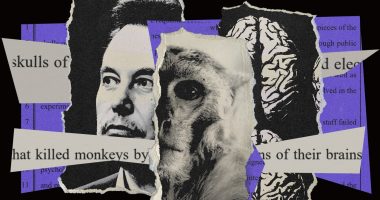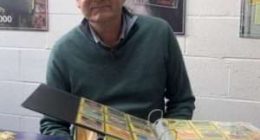
THE European Organization for Nuclear Research has restarted its Large Hadron Collider today, and new observations are already being recorded.
The European organization, also known as CERN, operates the largest particle physics laboratory in the world.
CERN’s main function is to provide the particle accelerators and other infrastructure needed for high-energy physics.
Today, there were collisions at unprecedented energy levels at the Large Hadron Collider (LHC), which was shut down three years ago.
Three never-before-seen particles have been discovered at the Large Hadron Collider (LHC), after Run 3 began.
The international LHCb collaboration observed the first-ever pair of “tetraquarks,” and a new kind of “pentaquark,” according to CERN’s website, and the findings were presented at the CERN seminar today.
Read our CERN Hadron Collider live blog for the latest news and updates…
-
Who is Robert Cailliau, continued
The event was oversubscribed with 380 web pioneers and marked a real turning point in the development of the internet.
As well as being such an esteemed computer scientist, Cailliau also authored the book How the Web Was Born in 2000.
He went on early retirement in 2007 after dedicating his time to public communication.
-
Who is Robert Cailliau?
Robert Cailliau collaborated with Berners-Lee on the world wide web and created its iconic WWW logo.
The Belgian proposed the first hypertext system for CERN in 1987 which would go on to develop the internet as we know it.
He likewise organised the first Internation World Wide Web Conference at CERN in 1994.
-
ENQUIRE wasn’t very accessible
However, ENQUIRE wasn’t up to scratch for what the internet inventor had envisioned and he came back to CERN in 1984 to work on the system.
He realized that he wanted the world wide web to be similar to this prototype “but accessible to everybody”.
-
What was ENQUIRE?
Berners-Lee wrote his first proposal for the internet at CERN in 1989, but refined it with Belgian systems engineer Robert Cailliau the year after.
Yet, the scientist had previously made an early predecessor of the world wide web in 1980 under the name ENQUIRE.
The software project was a simple hypertext program which Berners-Lee named after an old how-to book, Enquire Within Upon Everything.
-
What is the Higgs Boson?
The discovery of the Higgs boson – or “God particle” – was monumental.
The particle gives matter mass and holds the physical fabric of the universe together.
Its existence had been debated for decades and researchers finally confirmed it on July 4, 2012.
The landmark discovery of the particle was made at the Large Hadron Collider (LHC) – the “Big Bang” atom-smasher near Geneva.
It was announced exactly 10 years ago by Cern, the European Organisation for Nuclear Research.
-
How big is the Large Hadron Collider?
The Large Hadron Collider sits at a whopping 27 kilometer (17 miles) ring of magnets, making it the biggest accelerator in the world.
The circumference is made up of thousands of magnets surrounding the beams around the LHC, all of different varieties and sizes.
Generally, accelerators are required to be large in order to prevent breakage.
-
What does the Large Hadron Collider do?
As the world’s largest and most powerful particle accelerator, the Large Hadron Collider, also known as LHC, was built to study subatomic particles.
These minuscule particles are the smallest building blocks of all things in the universe.
The collider fires particle beams at each other in opposite directions in two tubes kept at ultrahigh vacuum.
These beams are kept at -456.34 Fahrenheit and travel close to the speed of light, ensuring the highest discovery potential as well as precision.
-
What is the Large Hadron Collider?
The European Council for Nuclear Research (CERN) has its headquarters in Geneva, which lies on the border of France and Switzerland.
The LHC is a massive ring of superconducting magnets for ground-breaking scientific research that is located 100 meters below.
Although accelerators were created in the 1930s to study the structure of atoms, the LHC is the largest of its type.
Scientists undertake experiments within the enormous apparatus to make revolutionary discoveries about the nature of the cosmos, such as the discovery of a “God particle” 10 years ago.
-
Berners-Lee had some help
Together with Berners-Lee, Robert Cailliau designed the world wide web’s recognizable WWW logo.
In 1987, the Belgian suggested the first hypertext system to CERN, which later led to the creation of the internet as we know it today.
The inaugural International World Wide Web Conference was also organized by him in 1994 at CERN.
Three hundred and eighty online pioneers oversubscribed the event, which represented a significant turning point in the evolution of the internet.
In addition to being a renowned computer scientist, Cailliau wrote How the Web Was Born in 2000.
After investing his time in public communication, he took early retirement in 2007.
-
Who is Tim Berners-Lee?
The world wide web was created by Tim Berners-Lee, who is credited with creating the internet at CERN.
He now holds the positions of professor at MIT and professorial fellow in computer science at Oxford.
He has received various honors and accolades throughout the years, including a knighthood from the Queen in 2004 and a Turing Award in 2016.
He was listed as one of the 100 Most Important People of the 20th century in 1999 by Time magazine.
-
A CERN employee created the Internet
In fact, a British physicist at CERN created the Internet in 1989.
However, the organization is not only located in Geneva, on the Franco-Swiss border, at the mega-lab where the Large Hadron Collider has been switched on.
Over 10,000 scientists from more than 100 nations make up the huge global network known as CERN.
Therefore, Tim Berners-Lee developed the concept of the internet to enable these scientists from universities and institutions throughout the world to exchange knowledge, discoveries, and research.
He sought to create a worldwide information system by fusing the technologies of personal computers, networks, and hypertext.
-
CERN allows visitors
Visitors are unable to enter the Large Hadron Collider’s tunnel, but you may learn a lot about particle physics by visiting the CERN headquarters in Geneva.
Free guided tours of the whole laboratory are available, however, space is limited and reservations are necessary.
There are very few underground detector excursions available, but there is a lot to see elsewhere.
CERN has two primary locations, one in France and the other in Switzerland, due to its border location.
At the Meyrin site in Switzerland, there is a visitor reception.
-
Where is CERN headquarters located?
The CERN headquarters are located in Geneva, close to the Swiss-French border.
The LHC, a massive, 17-mile ring of superconducting magnets made up of a variety of structures, is located 100 meters underground.
Before colliding, two high-energy particle beams move within the LHC at speeds that are almost as fast as light.
The accelerator’s beams are propelled by thousands of magnets of various shapes and sizes, and to operate at peak efficiency, they must be maintained at a temperature of -456.34 degrees Fahrenheit, which is colder than space.
-
What does the Large Hadron Collider do?
As the world’s largest and most powerful particle accelerator, the Large Hadron Collider, also known as LHC, was built to study subatomic particles.
These minuscule particles are the smallest building blocks of all things in the universe.
The collider fires particle beams at each other in opposite directions in two tubes kept at ultrahigh vacuum.
These beams are kept at -456.34 Fahrenheit and travel close to the speed of light, ensuring discovery potential as well as precision.
-
Budget spent on machine building
The CERN Council Resolution of March 8, 2022, suspends the Russian Federation’s position as an observer.
The finance, development, and maintenance of the experiments at CERN are handled by funding organizations from each of the aforementioned state types.
The cost of the experiments is only partially covered by the funding, which is mostly used to create apparatus like the Large Hadron Collider.
The US committed $531million to the LHC project, which had a total cost of $4.75billion, in a 1997 agreement, per CERN.
-
CERN gets funding from 23 member states
The 23 member states of the European Center for Nuclear Research, or CERN for short, as well as a few non-member governments, provide financial support to the laboratory.
Several more European nations have since joined the CERN pact, which was initially signed in 1953 by the original 12 signatories.
The member nations share responsibility for key organizational choices as well as capital and operating expenditures associated with the programs of the historic lab.
International organizations including the European Union and UNESCO, as well as Japan and the US, all have Observer status with the Large Hadron Collider.
-
Unanswered questions about Higgs Boson
Researchers say there are still a lot of unanswered questions about the particle, like: can it interact with dark matter and reveal the nature of this mysterious form of matter?
It’s unknown what generates the Higgs boson’s mass and self-interaction.
Researchers also don’t know whether the particle has twins or relatives.
-
Why Higgs matter matters
The discovery of Higgs was vital to the Standard Model – the theory that describes the web of particles, forces and interactions that make up the universe.
Without the Higgs boson to give matter mass and weight, there could be no Standard Model universe.
Cern theorist Michelangelo Mangano said: “And while all the results obtained so far are consistent with the Standard Model, there is still plenty of room for new phenomena beyond what is predicted by this theory.”
Luca Malgeri, a spokesman for CMS – one of two of the LHC’s giant detectors, along with Atlas – said: “The Higgs boson itself may point to new phenomena, including some that could be responsible for the dark matter in the universe.
“Atlas and CMS are performing many searches to probe all forms of unexpected processes involving the Higgs boson.”
-
Bigger and better things
“We have started a feasibility study for a 91 km collider within the local area,” said one of the panelists at the Q&A.
The feasibility study will take place between two and five years.
-
Viewers follow along with live stream
There are more than 22,000 viewers in the CERN live stream right now.
Following the first collision, viewers took to Twitter to congratulate the physicists for their success.
One person wrote: “Hopefully this will bring us some new and interesting physics!”
-
Technical difficulties
Some of the CERN control rooms are not connected to the live stream.
-
More discoveries
“We’re expecting to see lots more Higgs and be able to do more precision measurements to understand what the Higgs is telling us about nature,” said a CERN rep during the Q&A.
-
Four-year run
Run 3 will run until 2025, according to the physicists.
-
Q&A coming up
Representatives form CERN will be leading a Q&A regarding the LHC experiment.
-
‘Lifetime experience’
ATLAS spokesperson Andreas Hoecker says: “This is an absolutely overwhelming moment for all of us.”
This post first appeared on Thesun.co.uk







